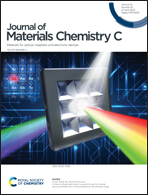Reducing noise current in exfoliated WS2 nanosheets using an ultra-nanocrystalline diamond substrate and their enhanced NIR photodetection properties†
Abstract
Herein, we report the fabrication of a near-infrared (NIR) WS2 nanosheet/ultra-nanocrystalline diamond (UNCD) heterojunction photodetector through a liquid phase exfoliation process and microwave plasma-enhanced chemical vapor deposition (MPECVD) method, for the first time. The integration of two forms of nanodiamond into layered WS2 enables a broadband spectral response with high sensitivity to the NIR region at room temperature. The addition of nanodiamonds into layered WS2 not only enhances the photoresponse of the present heterostructure, but also improves the device stability by reducing its noise current through defect engineering and surface modification. The surface coating of layered WS2 becomes continuous on nitrogen-incorporated UNCD films, which tremendously reduces the noise current by increasing the charge carrier mobility and density. As a result, the MD–WS2/NUNCD photodetector shows an ultra-high responsivity of 31.2 A W−1 with a fast response speed of 60/56 ms rise/fall time. This can be ascribed to the fraction of sp2 carbon, and the built-in electric field at the interface of the n–n junction extends the carrier lifetime and produces high photocurrent towards a broadband spectrum. This work opens up a pathway for combining UNCD films and 2D TMD materials to achieve high-performance and easy-to-process heterojunction-based optoelectronic devices.



 Please wait while we load your content...
Please wait while we load your content...